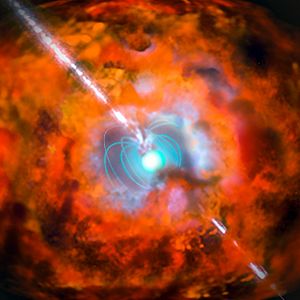Magnetar facts for kids
A magnetar is a special kind of neutron star. It has an incredibly strong magnetic field. These stars are some of the most powerful magnets in the entire universe. They can create huge bursts of X-rays and gamma rays.
Contents
What is a Magnetar?
Like other neutron stars, magnetars are quite small. They are about 20 kilometres (12 mi) across, which is roughly the size of a city. But they are super heavy! A magnetar can weigh 2 to 3 times more than our Sun. Imagine a spoonful of magnetar material. It would weigh over 100 million tons!
Magnetars are different from other neutron stars because of their magnetic fields. Their fields are much, much stronger. They also spin very fast. Most neutron stars spin once every 1 to 10 seconds. Magnetars, however, can spin in less than one second.
Their powerful magnetic fields cause them to shoot out strong bursts of X-rays and gamma rays. A magnetar's active life is not very long. Their super strong magnetic fields start to fade after about 10,000 years. After this, they stop sending out strong X-rays. Scientists think there might be 30 million or more inactive magnetars in our Milky Way galaxy.
Sometimes, "starquakes" happen on the surface of a magnetar. A starquake is like an earthquake, but on a star. These quakes can shake up the magnetar's magnetic field. This often causes huge gamma ray flares. Scientists on Earth have recorded these powerful flares. Some famous ones happened in 1979, 1998, and 2004.
Magnetar's Super Strong Magnetic Field
Magnetars have unbelievably strong magnetic fields. They can be 100 million to 100 billion times stronger than any magnet made by humans. They are also quadrillions (a million billion) of times stronger than Earth's own magnetic field.
To give you an idea:
- Earth's magnetic field is very weak, about 30 to 60 microteslas.
- A strong neodymium magnet (like those on your fridge) is about 1.25 tesla.
- A magnetar's field can be 10,000,000,000 tesla!
A magnetar's magnetic field would be deadly even from 1000 km away. It would mess up the atoms in your body, making life impossible. If a magnetar were halfway between Earth and the Moon, it could erase all the information on every credit card on Earth! As of 2010, magnetars are the strongest magnetic objects ever found in the universe.
In such an extreme magnetic field, strange things happen. X-ray photons (tiny light particles) can split in two or join together. Even empty space around the magnetar changes. It becomes like a special crystal. Atoms themselves get stretched into long, thin shapes. For example, a hydrogen atom in a super strong magnetar field would become 200 times narrower than normal.
How Magnetars Form
Magnetars are born when a very large star dies. When a star runs out of fuel, it can explode in a huge event called a supernova. If the star is big enough, its core collapses into a tiny, super dense object called a neutron star.
During this collapse, the star's magnetic field gets much, much stronger. Imagine squeezing a large magnet into a tiny space. Its magnetic power would increase a lot! Scientists believe that if a new neutron star has the right spin, temperature, and magnetic field, a special process can happen. This process turns heat and spinning energy into even more magnetic energy. This boosts the already huge magnetic field (which is normally 100 million teslas) to over 100 billion teslas. When this happens, you get a magnetar!
It's thought that about one out of every ten supernova explosions creates a magnetar. The others usually form a more common neutron star or a pulsar.
Images for kids
-
Artist's idea of a powerful magnetar in a star cluster.
-
On December 27, 2004, a burst of gamma rays from SGR 1806−20 reached Earth. This burst was so powerful it affected Earth's atmosphere, even though it was about 50,000 light-years away (artist's idea shown).
See also
 In Spanish: Magnetar para niños
In Spanish: Magnetar para niños







